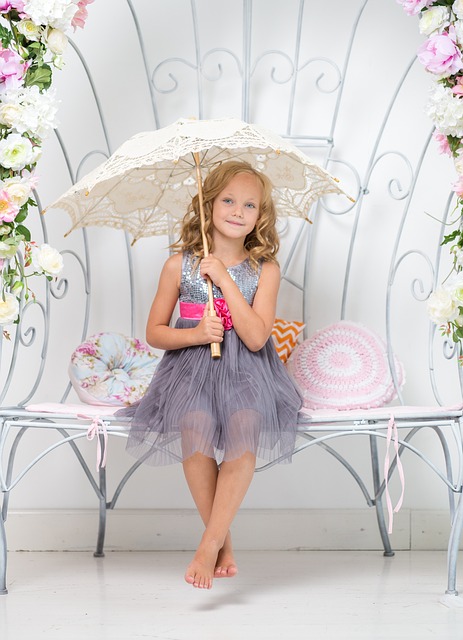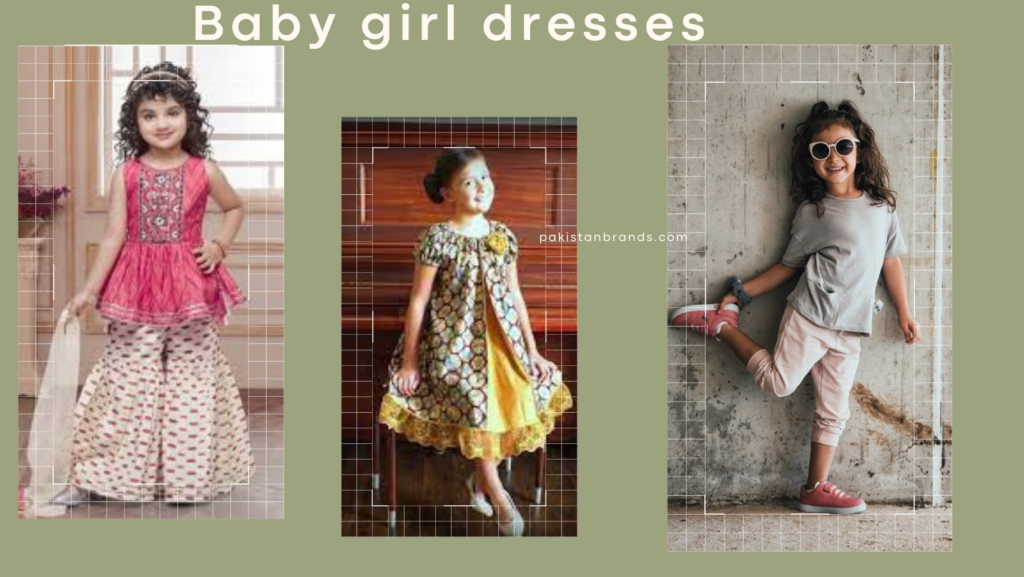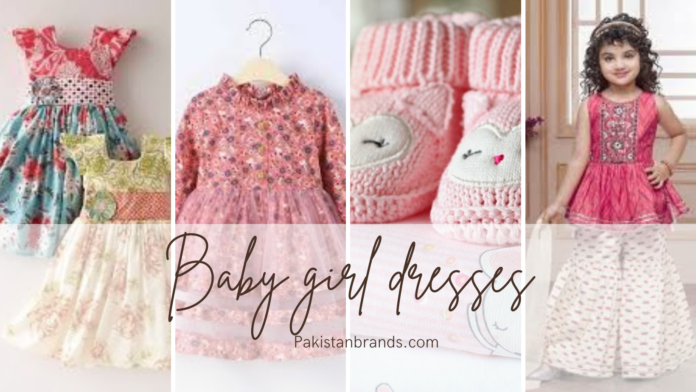Welcome to the ultimate guide for choosing the perfect baby girl’s dresses. At Pakistanbrands.com, we understand the significance of dressing your little one in stylish, comfortable outfits.
With the help of our in-depth research, you will be better equipped to choose baby girl dresses by gaining important knowledge and professional advice.
To see clothes for baby boy read Baby boy clothing brands
Knowing What Your Baby Girl Needs:

It’s critical to consider your child’s requirements before exploring the world of baby girl gowns.
Baby skin is particularly sensitive and needs special care. Prioritize soft, breathable, and hypoallergenic fabrics while choosing dresses to avoid skin rashes or discomfort.
For simple dressing and diaper changes, choose gowns with practical elements like snaps or buttons.
Picking the appropriate size:
For your baby girl to fit comfortably, choosing the correct size is essential. It’s crucial to remember that sizes can vary between companies and geographical areas.
Measure your baby girl’s height, weight, and chest circumference precisely to find the right size. For information on sizes, consult the size charts supplied by the manufacturers.
Remember, selecting a slightly larger size to accommodate growing rather than a tight fit is preferable.
Investigating various dress styles:
Baby girl gowns are available in a variety of designs, each with its own charm and appeal.
Here are some popular baby girl clothing trends to consider:
A-Line Gowns:
Fitted bodices of A-Line dresses eventually extend into an A-shape, resembling the letter “A.”
There is plenty of room for movement and play in this style for baby girl dresses, which looks good on various body types.
A-Line dresses frequently have lovely accents like bows, lace frills, or ruffles that provide an added touch of cuteness.
Tutu Dresses:
Tutu dresses are perfect for special occasions or parties. They typically feature a fluffy tulle skirt that adds a whimsical and playful element to your baby girl’s outfit.
Tutu dresses often come in vibrant colors and can be accessorized with a matching headband or bow for an enchanting look.

Smocked Dresses:
Smocked dresses have a timeless charm that never goes out of style. They feature intricate smocking details on the bodice, creating a textured and decorative look.
Smocked dresses are available in various fabric choices, including cotton, linen, and silk, making them suitable for both casual and formal occasions.
Floral Dresses:
Floral dresses exude a sense of freshness and vibrancy for baby girl dresses. These dresses are adorned with beautiful floral prints, ranging from dainty blossoms to bold blooms.
Floral dresses are versatile and can be paired with a cardigan or leggings for cooler weather or worn as is during warmer seasons.
Caring for Baby Girl’s Dresses:
To ensure the longevity of your baby girl’s dresses, proper care is essential. Here are some tips to keep in mind:
- Follow the care instructions provided by the manufacturer to maintain the fabric’s quality.
- Use gentle detergents specifically formulated for baby clothes to avoid any harsh chemicals.
- Wash dresses in cold water to prevent color fading and shrinkage.
- Avoid using bleach or fabric softeners that may irritate your baby girl’s skin.
- Dry dresses in a gentle cycle or air-dry them to prevent damage.

Conclusion:
Congratulations! You are now equipped with valuable knowledge for finding the perfect baby girl’s dresses.
Remember to prioritize comfort, choose the right size, and explore various dress styles to make your little one look adorable and stylish.
By following our care tips, you’ll ensure that these dresses last longer, providing both comfort and style for your baby girl.
How to Dress a Newborn Baby?
Some of the most essential tips are:
Choose soft and breathable fabrics: Opt for clothes made of cotton or other gentle materials to avoid irritation and ensure good airflow.
Dress in layers: Newborns have difficulty regulating their body temperature, so dressing them in layers allows you to add or remove clothing as needed.
Easy access for diaper changes:
Select clothes with snaps or buttons in the diaper area for easy access during diaper changes.
Avoid clothes with too many embellishments: Ruffles, buttons, or bows can be uncomfortable for newborns, so keep their clothing simple and fuss-free.
Protect the head:
Use soft hats or caps to keep your newborn’s head warm, especially in cooler environments.
What are the Colors for Baby Girl Clothes?
Here are some popular colors for baby girl clothes:
Pink: A classic choice for baby girls, ranging from soft pastel shades to vibrant pinks.
Pastels: The trending colors are light shades of blue, green, yellow, or lavender.
Neutral colors: Baby girls can also wear neutral colors like white, cream, gray, or beige, which offer a versatile and timeless option.
Bright colors: As we know the brightness attract the babies that is why this type of colours are highly preferable.
Ultimately, The personal preference pay role much.
How to Dress Your Baby Girl in Style?
Dressing your baby girl in style can be fun and creative:
Pair a patterned top with solid-colored leggings or a tutu skirt with a plain top.
Accessorize: Add cute accessories like headbands, bows, or hats to complement your baby girl’s outfits. Be mindful of safety and choose accessories that won’t pose a choking hazard.
Layering: Layering can add depth and style to your baby girl’s outfits. Combine onesies, cardigans, leggings, and socks to create fashionable ensembles.
Consider the occasion: Dress your baby girl appropriately for the occasion. Opt for more formal dresses for special events or parties and choose comfortable and casual outfits for everyday wear.
Pay attention to details: Look for dresses with unique embellishments like ruffles, lace, or embroidery to add a touch of elegance and style.
Comfort is key: While style is important, ensure that your baby girl’s clothing is comfortable and allows for easy movement. Avoid outfits with scratchy tags or tight-fitting clothes that might restrict her movement.
Remember, the most important thing is to dress your baby girl in clothes that make her feel comfortable, happy, and loved.
What Should Baby Wear First Born?
When dressing your newborn baby for the first time, simplicity and comfort are key. Here are some essentials for the initial days:
Onesies or bodysuits: These one-piece garments are a staple for newborns. They provide comfort, easy diaper access, and warmth.
Kimono-style tops: These tops open in the front, making it easier to dress your baby without pulling anything over their head.
Soft pants or leggings: Pair the onesies or tops with soft and stretchy pants or leggings to keep your baby’s legs warm.
Socks or booties: Keep your baby’s feet cozy with soft socks or booties.
Swaddling blanket: Swaddling can help newborns feel secure and promote better sleep. Use a lightweight and breathable blanket for swaddling.
It’s important to avoid clothing with small buttons, loose ribbons, or any other choking hazards.
Newborns spend a significant amount of time sleeping, so prioritize their comfort and safety when selecting their first outfits of baby girl dresses.
What Do Newborns Wear After Birth?
After birth, newborns typically wear a hospital-provided garment until they are ready to go home.
These garments are usually soft and comfortable, designed to keep the baby warm and allow for easy medical examinations.
Once you’re ready to dress your newborn in their own clothes, opt for soft, breathable onesies or bodysuits paired with leggings or pants.
Ensure that the clothing is easy to put on and remove for diaper changes. Dressing your newborn in layers allows you to adjust their clothing according to the room temperature and their comfort.
What Colour Makes Babies Happy?
Babies are often drawn to bright and vibrant colors that stimulate their senses and capture their attention.
While individual preferences may vary, colors such as yellow, red, and orange are known to elicit feelings of happiness and excitement in many babies.
These colors are vibrant and energetic, creating a stimulating environment for their developing senses.
It’s important to expose babies to a variety of colors to foster their visual development and provide a rich sensory experience for baby girl dresses.
What Are Baby’s Favorite Colors?
Babies may not have distinct preferences for specific colors since their color perception and preferences develop over time.
However, babies are generally attracted to bright and contrasting colors that capture their attention and stimulate their visual senses.
Bold primary colors such as red, blue, and yellow often elicit interest and engagement from babies.
Experiment with different colors to see which ones captivate your baby’s attention and make them curious and engaged with their surroundings.
How to Dress a Baby Easily?
Dressing a baby can sometimes be a challenge, but with a few tips, it can become easier and more efficient:
Choose clothing with wide openings: Look for onesies or tops that have wide neck openings and snaps or buttons at the crotch area. This makes it easier to slide the clothing over the baby’s head and allows for quick diaper changes.
Use one-piece outfits: One-piece outfits like rompers or footed pajamas can simplify the dressing process. They eliminate the need to coordinate multiple pieces of clothing or baby girl dresses.
Opt for stretchy materials: Clothing made of stretchy materials, like cotton blends or knits, can make it easier to dress your baby as they provide flexibility and give while putting the clothes on.
Dress from the feet up: If your baby doesn’t like clothes being pulled over their head, try dressing them from the feet up. Start with pants or leggings, then move to tops or onesies.
How to Arrange Baby Dresses?
Organizing and arranging baby dresses can help make dressing your baby more convenient. Here are some tips for arranging baby dresses:
Categorize by size: If you have dresses in different sizes, group them together according to size. This makes it easier to find the right dress as your baby grows.
Sort by occasion: Separate dresses based on their purpose or occasion. For example, keep casual dresses separate from formal ones, making it easier to choose an appropriate outfit for the day.
Organize by style or season: If you have a variety of dress styles or seasonal dresses, consider organizing them accordingly. Group together sundresses, party dresses, or dresses suitable for colder weather.
Use hangers or dividers: Hang dresses on small hangers designed for baby clothes to prevent wrinkling and maintain their shape. Alternatively, use dividers or separate sections in drawers to keep dresses organized and visible.
Label or arrange by color: If you prefer a specific color scheme or want to make it easier to coordinate outfits, you can organize dresses by color. This can help you quickly find matching pieces or create visually pleasing combinations.
Find an arrangement method that works best for you, considering your available space and personal preferences. Regularly declutter and assess your baby’s dress collection to ensure you have appropriate and well-maintained options.
How Long Will Baby Wear Newborn Diapers?
The duration for which a baby wears newborn diapers can vary. It depends on factors such as the baby’s size at birth, their growth rate, and individual differences. On average, newborns wear diapers labeled as “newborn” or “size N” for approximately the first few weeks to a month. As the baby grows, you may need to transition to larger diaper sizes.
What Do Babies Wear After Diapers?
After diapers, babies typically transition to wearing training pants or underwear once they start potty training.
This transition usually occurs around the age of 2 to 3 years, but it can vary depending on the child’s readiness and development.
Training pants are designed to be more like regular underwear but with added absorbency to catch small accidents during the potty training process.
They often have a more elastic waistband or adjustable sides, making it easier for toddlers to pull them up and down independently.
Once your child becomes fully potty trained, they can wear regular underwear.
What Color Makes Babies Cry More?
There is no specific color that universally makes babies cry more.
Crying in infants is typically associated with various factors, such as hunger, discomfort, fatigue, overstimulation, or the need for attention and soothing. Color alone is unlikely to be a significant trigger for crying in babies.
What Color Attracts Kids?
Colors that attract kids can vary based on personal preferences and individual development.
However, children are often drawn to bright and vibrant colors that stimulate their senses and capture their attention. Some colors that commonly attract kids include:
Red: Red is associated with energy, excitement, and stimulation. It can evoke a sense of urgency or grab children’s attention quickly.
Yellow: Yellow is a cheerful and bright color that can create a sense of happiness and warmth.
What Colors Calm Babies?
Colors that can have a calming effect on babies may vary based on individual preferences and experiences.
However, softer, muted tones are generally considered soothing. Some colors that are often associated with calming effects for babies include baby girl dresses:
Pale blue: Light blue shades can create a sense of calmness and tranquility.
Soft green: Gentle shades of green can evoke a feeling of relaxation and harmony.
Lavender: This delicate shade of purple is often associated with calmness and can help create a soothing atmosphere.
Pastel pink: Pale pink can have a calming effect and promote a sense of comfort and relaxation.
Cream or off-white: Neutral and warm tones like cream or off-white can create a serene and peaceful ambiance.

